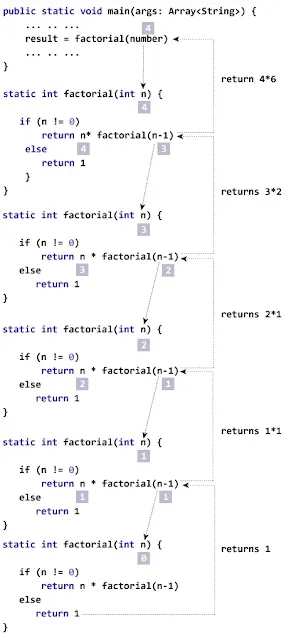Java Recursion: Understanding and Implementing the Concept
Recursion is a programming technique in which a function calls itself to solve
a problem. It is an important concept in computer science and has several
practical applications in software development. Java, being a high-level
programming language, supports recursion and enables developers to write
elegant and concise code.
A recursive function has two parts: the base case and the recursive case. The
base case defines the end condition for the recursion, while the recursive
case calls the function again with a modified input. If the base case is not
reached, the function will keep calling itself, leading to an infinite loop.
To avoid this, it is crucial to define the base case correctly and to choose
the input correctly for the recursive case.
To prevent infinite recursion, it's crucial to provide an exit condition within the method. This is achieved using an if...else statement or a similar approach, which acts as a termination mechanism for the recursive call. Without this, the method would be called repeatedly, leading to an infinite loop.
Example: Factorial of a Number Using Recursion
Let's consider an example to understand recursion in Java. Consider the
problem of computing the factorial of a number. Factorial of a number is
defined as the product of all the numbers from 1 to that number. For
example, the factorial of 5 is 5! = 5 * 4 * 3 * 2 * 1 = 120.
Here is a recursive implementation of the factorial function in Java:
class Factorial { static int factorial( int n ) { if (n != 0) // termination condition return n * factorial(n-1); // recursive call else return 1; } public static void main(String[] args) { int number = 4, result; result = factorial(number); System.out.println(number + " factorial = " + result); } }
Output:
4 factorial = 24
Here, notice the statement,
return n * factorial(n-1);
When n is equal to 0, the if statement returns false hence 1 is returned. Finally, the accumulated result is passed to the main() method.
Working of Factorial Program
The image below will give you a better idea of how the factorial program is executed using recursion.Advantages and Disadvantages of Recursion
Advantages of Recursion:1) Simplicity: Recursion can make certain problems much simpler to solve and understand, as it allows you to break a complex problem into smaller and more manageable sub-problems.
2) Reusability: Recursive functions can be easily reused for similar problems, as long as the base case and recursive case are defined correctly.
3) Conciseness: Recursion can lead to a more concise and elegant solution compared to an iterative solution, as it eliminates the need for loops and complex control structures.
4) Abstraction: Recursion allows for the abstraction of complex operations into simple, self-contained functions that can be combined to solve more complex problems.
Disadvantages of Recursion:
1) Overhead: Recursive calls require more memory than iterative solutions, as each recursive call creates a new stack frame that needs to be stored in memory.
2) Performance: Recursion can be slower than an iterative solution, as each recursive call takes longer to complete due to the overhead of creating new stack frames.
3) Risk of infinite recursion: If the base case and recursive case are not defined correctly, the recursive call can lead to an infinite loop.
4) Complexity: Recursion can lead to more complex code that is harder to debug and maintain, especially for those who are not familiar with the concept of recursion.
LETS SEE AN ANOTHER EXAMPLE OF JAVA RECURSION:
Here is a recursive implementation of the Fibonacci function in Java:
public static int fibonacci(int n) { if (n <= 1) { return n; } else { return fibonacci(n - 1) + fibonacci(n - 2); } }
This example demonstrates the power of recursion in solving mathematical problems in a simple and elegant manner. However, it is important to note that the performance of this implementation is not optimal, as it takes a lot of time for larger values of n due to the repeated calculations. An optimized implementation, such as using dynamic programming, can improve the performance of the Fibonacci function.

.jpg)



.jpg)
